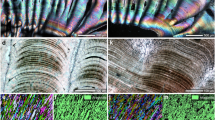Abstract
Recent and fossil otoliths from 25 different fishes have been studied for their amino acid content and for their C13/C12 and O18/O16 distribution in the carbonate fraction. The selection includes specimens from a wide phylogenetic range as well as from various freshwater and marine habitats. All otoliths are composed of aragonite, and their total organic matter ranges from 0.2 to 10%. The organic matter is a protein (MW>150,000), which is characterized by a high abundance of acidic amino acids. In comparison to molluscs that exhibit a wide variety of different mineralized tissues which are species specific, the proteinaceous matter of all otoliths is chemically rather uniform. The high abundance of oxygen-rich amino acids accounts for the ease of mineralization of the organic template. Namely, oxygen supplied by carboxyl grops is used for the coordination of Ca++ ions, resulting in the formation of metal ion coordination polyhedra. Carbonate groups linked via hydrogen bridges to the template will exchange their oxygen with that of the metal polyhedra to stabilize the structure; Ca++O9 polyhedra are the consequence. Subsequent nucleation and crystal growth will lead to aragonite. Oxygen and carbon isotope data indicate that the aragonite is formed close to isotopic equilibrium with the sea. This is surprising, because seawater has no direct access to the inner ear where the otolith orginates. Isotope data may serve a threefold purpose: (1) to determine the mean water temperature where the fish lived, (2) to distinguish between fresh water and marine fish in ancient deposits, and (3) to reveal information on migrtory tendencies of fish.
Similar content being viewed by others
Literature cited
Craig, H.: Isotopic standards for carbon and oxygen and correction factors for mass-spectrometric analysis of carbon dioxide. Geochim. et cosmochim. Acta 12, 133–149 (1957).
Degens, E. T., B. W. Johannesson and R. W. Meyer: Mineralization processes in molluscs and their paleontological significance. Naturwissenschaften 54, 638–640 (1967a).
—, D. W. Spencer and R. H. Parker: Paleobiochemistry of molluscan shell proteins. Comp. Biochem. Physiol. 20, 533–579 (1967b).
Devereux, I.: Temperature measurements from oxygen isotope ratios of fish otoliths. Science, N.Y. 155, 1684–1685 (1967).
Giebe, E. and A. Scheibe: Eine einfache Methode zum qualitativen Nachweis der Piezoelektrizität von Kristallen. Z. Phys. 33, 760–766 (1925)
Glimcher, M. J.: Specificity of the molecular structure of organic matrices in mineralization. Am. Ass. Adv. Sci. Publs No. 64, 421–487 (1960).
Greenwood, P. H., D. E. Rosen, S. H. Weitzman and G. S. Myers: Phyletic studies of teleostean fishes, with a provisional classification of living forms. Bull. Am. Mus. nat. Hist. 131, 339–456 (1966).
Matheja, J. and E. T. Degens: Molekulare Entwicklung mineralisationsfähiger organischer Matrizen. Neues Jb. Geol. Paläont. Mh. 1968, 215–229 (1968).
Morris, R. W. and L. R. Kittleman: Piezoelectric property of otoliths. Science, N.Y. 158, 368–370 (1967).
Sanz-Echeverria, J.: Identificación de los peces de la familia Centrolophidae de España por medio de los otolitos. Real Sociedad Espafiola de Historia Natural, Madrid. Tomo Extraord. 151–156 (1949).
Shamos, M. H. and L. S. Lavine: Piezoelectricity as a fundamental property of biological tissue. Nature, Lond. 213, 267–269 (1967).
— and M. I. Shamos: Piezoelectric effect in bone. Nature,Lond. 197, 1–81 (1963).
Spencer, D. W. and E. T. Degens: (unpublished results).
Author information
Authors and Affiliations
Additional information
Communicated by G. L. Voss, Miami
Contribution No. 2214 from the Woods Hole Oceanographic Institution.
Rights and permissions
About this article
Cite this article
Degens, E.T., Deuser, W.G. & Haedrich, R.L. Molecular structure and composition of fish otoliths. Marine Biol. 2, 105–113 (1969). https://doi.org/10.1007/BF00347005
Accepted:
Issue Date:
DOI: https://doi.org/10.1007/BF00347005




